COVID-19 Out-of-Pocket Spending Lower with Cost-Sharing Waivers
Few patients had high out-of-pocket spending for facility services during a COVID-19 hospitalization, indicating that services cost-sharing waivers may have covered the costs.

Source: Getty Images
- Cost-sharing waivers for COVID-19 hospitalizations have the potential to significantly reduce out-of-pocket healthcare spending, as long as they are comprehensive and cover all hospital-related services, a JAMA Network Open study found.
During 2020, many payers waived cost-sharing for COVID-19 hospitalization and treatment in addition to the federally mandated cost-sharing waivers for testing and vaccination.
However, patients who were hospitalized for COVID-19 still may have faced high out-of-pocket costs even with the cost-sharing waivers if the waivers did not cover all hospital-related care.
Payers have started to lift coronavirus treatment cost-waivers as 2021 progresses, possibly exposing members to even higher out-of-pocket costs.
The high costs are due, in part, to the way that hospital reimbursement works.
Hospitals may bill for two different categories of service. Facility services include hospital-provided care, such as inpatient pharmacy and lab services and accommodations. Professional and ancillary services include inpatient care provided by clinicians and ancillary service providers like emergency department services or diagnostic testing.
Some payers may have only covered facility services and not professional and ancillary services under their cost-sharing waivers, leading to high out-of-pocket spending for some patients who were hospitalized for COVID-19.
To assess the impact of cost-sharing waivers on coronavirus-related treatment, researchers gathered data from the IQVIA PharMetrics Plus for Academics database and looked at 4,075 COVID-19 hospitalizations which occurred among 3,875 patients between March 1, 2020 and September 29, 2020.
Two-thirds of the hospitalizations that the researchers studied involved patients who had Medicare Advantage. The remaining 33.8 percent of hospitalizations were for privately insured patients.
Out-of-pocket spending for facility services and professional and ancillary services differed significantly for both private plan patients and Medicare Advantage patients.
Only 63 of the 1,377 hospitalizations for privately insured patients (4.6 percent) and 36 of the 2,698 hospitalizations for Medicare Advantage patients (1.3 percent) had out-of-pocket spending for facility services. The mean total of facility services out-of-pocket spending under private insurance and Medicare Advantage was $3,840 and $1,536, respectively.
Meanwhile, 70.3 percent of hospitalizations under private payers and 48.3 percent of the Medicare Advantage hospitalizations had out-of-pocket spending for professional and ancillary services. The mean total was $768 for privately insured patients and $257 for Medicare Advantage patients.
The most billed professional and ancillary services for privately insured patients were clinician services, while ambulance services were most common among Medicare Advantage payments, researchers noted.
While the database did not indicate whether the involved payers provided cost-sharing waivers for facility services, the researchers could assume, based on their analysis, that the absence of out-of-pocket spending was associated with the presence of a cost-sharing waiver.
Taking this into account, the researchers concluded that payers offered cost-sharing waivers for most of the facility services during hospitalization because of the low out-of-pocket spending for these services. However, the high out-of-pocket spending for professional and ancillary services suggested that payers did not provide waivers for those services.
The lack of comprehensive cost-sharing waivers for COVID-19 hospital services led to a high frequency of out-of-pocket spending that was concentrated among professional and ancillary services.
“Even if insurers intend for waivers to capture all hospitalization-related care, implementation problems may occur,” the researchers wrote. “For example, patients may be billed erroneously if insurers do not link clinician inpatient evaluation and management bills to the COVID-19 hospitalization.”
The study proposed a couple of ways for payers and clinicians to address the high out-of-pocket costs for professional and ancillary services for COVID-19 hospitalizations.
First, payers that provide cost-sharing waivers for facility services only should implement a comprehensive waiver that covers all services from admission to discharge, including professional and ancillary services, the researchers suggested.
For the payers that already offer comprehensive waivers, they should be sure to implement the waivers properly and to actively cover cost-sharing for all services.
Finally, clinicians may help mitigate consumers’ cost burden by urging patients to challenge any professional and ancillary service bills that a payer’s cost-sharing waiver should have covered.
Policymakers should consider enacting federal mandates that require payers to provide comprehensive cost-sharing waivers for COVID-19 hospitalizations and all accompanying services, the researchers concluded.
This recommendation is particularly timely as many private payers and Medicare Advantage payers have let their cost-sharing waivers for COVID-19 hospitalizations expire.
Nearly 75 percent of the two largest private payers in each state have ended cost-sharing waivers for COVID-19 hospitalization and treatment as of August 2021, a Kaiser Family Foundation brief revealed.
